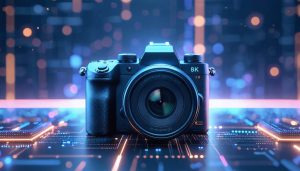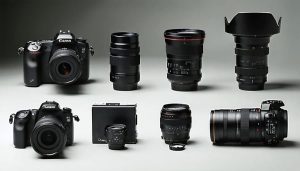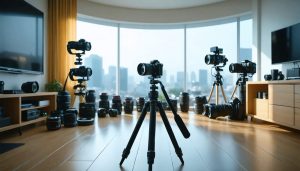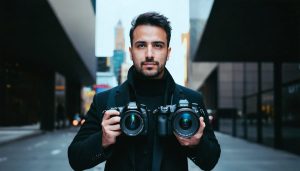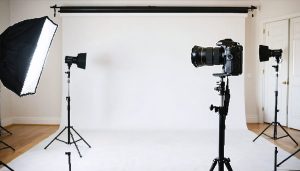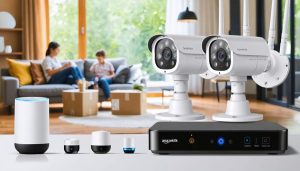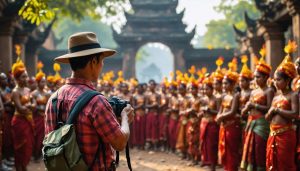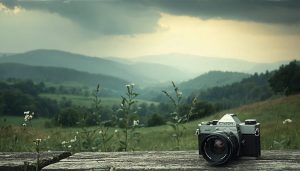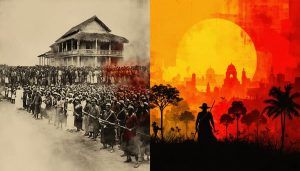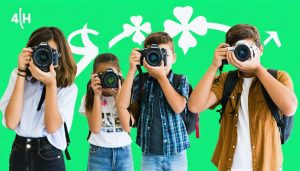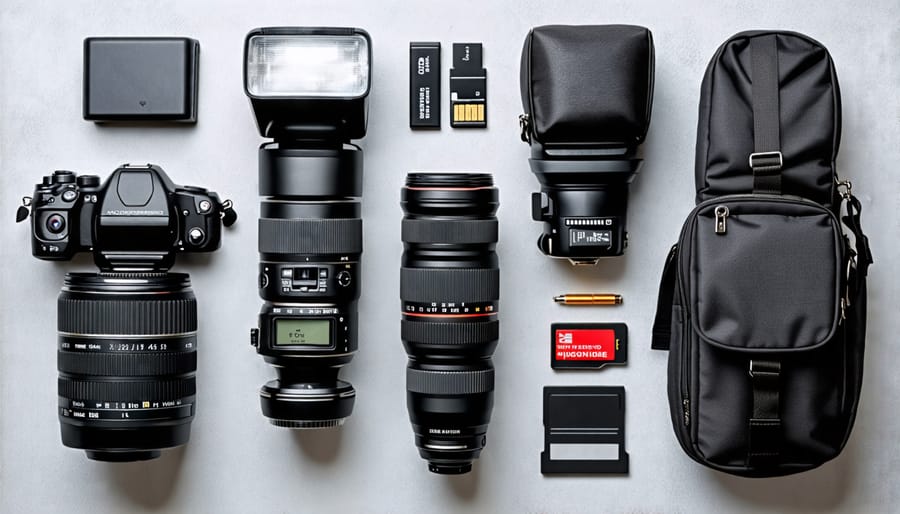
Choose a full-frame camera body that balances quality and affordability, such as an entry-level Canon, Nikon, or Sony model, to achieve professional image quality without breaking the bank. Invest in a versatile zoom lens with a range of 24-70mm and a fast aperture (f/2.8 or lower) to handle varied wedding scenarios and low-light situations. Add a telephoto lens (70-200mm) for capturing intimate moments from a distance and compressing perspective for flattering portraits. Secure a reliable external flash unit with bounce and swivel capabilities to illuminate subjects evenly and naturally, even in challenging lighting conditions.
The Camera Body
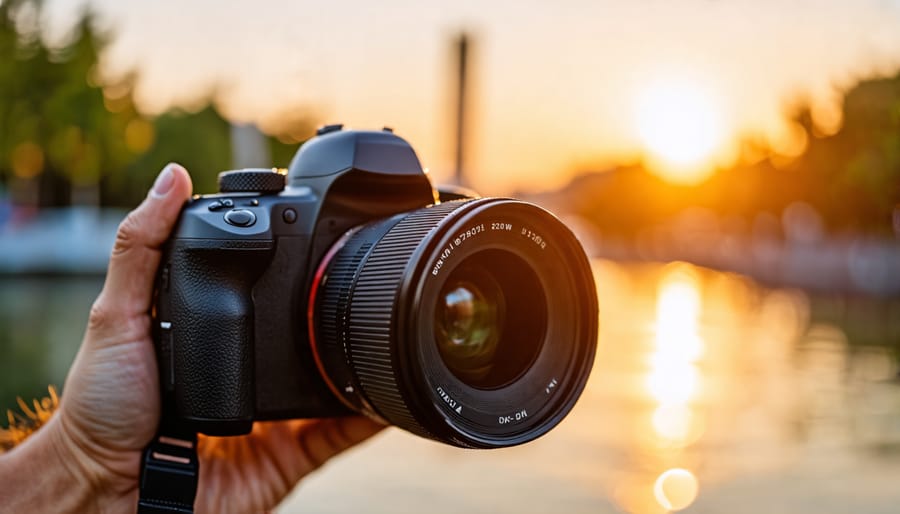
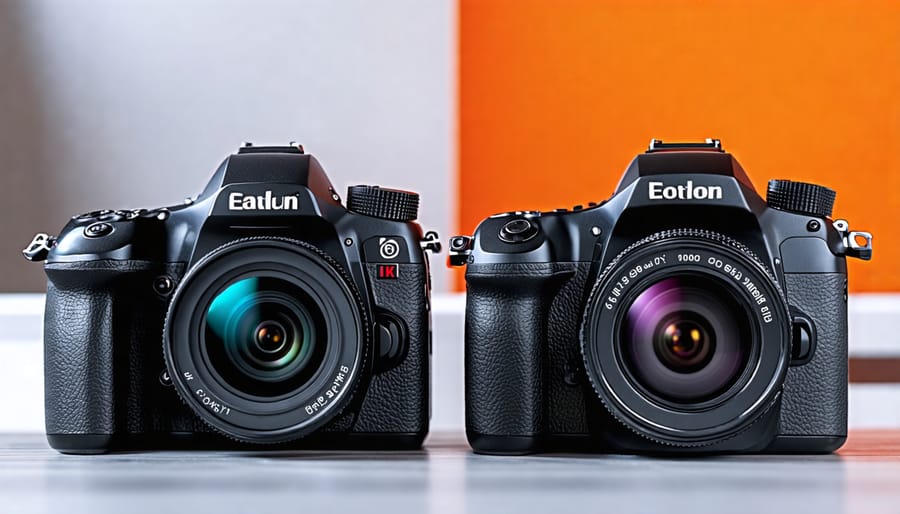
Full-frame vs. Crop Sensor
When it comes to wedding photography, the debate between full-frame and crop sensor cameras often arises. Full-frame cameras, with their larger sensors, offer superior low-light performance, wider dynamic range, and shallower depth of field. This allows for better image quality in challenging lighting conditions and more creative control over background blur. However, full-frame cameras tend to be more expensive and have a limited selection of wide-angle lenses.
On the other hand, crop sensor cameras, also known as APS-C, have smaller sensors but offer advantages such as increased reach with telephoto lenses, making them ideal for capturing distant subjects like the bride walking down the aisle. They are also more compact, lightweight, and affordable compared to full-frame cameras. Many mid-range options provide excellent image quality suitable for wedding photography.
Ultimately, the choice between full-frame and crop sensor cameras depends on your specific needs, budget, and shooting style. Full-frame cameras are ideal if you prioritize low-light performance and shallow depth of field, while crop sensor cameras offer a balance of affordability, portability, and versatility. Both types can produce stunning wedding photos in the hands of a skilled photographer who understands their equipment’s strengths and limitations.
Recommended Camera Models
When it comes to choosing a camera for wedding photography, beginners should look for models that offer a balance of performance, ease of use, and affordability. Entry-level DSLRs like the Canon EOS Rebel T8i or Nikon D3500 are excellent choices, providing good image quality and manual controls at a budget-friendly price point. These cameras feature APS-C sensors, which deliver sharp images with plenty of detail for prints and digital sharing.
For those willing to invest a bit more, mid-range mirrorless cameras such as the Sony A6400 or Fujifilm X-T30 offer advanced features in a compact form factor. These models boast fast autofocus systems, high-resolution electronic viewfinders, and the ability to shoot 4K video – all valuable assets for capturing the fast-paced action of a wedding day.
When selecting a camera, consider factors like low-light performance, autofocus speed, and ergonomics. Look for models with good high ISO capabilities to ensure clear images in dimly lit reception halls or churches. Responsive autofocus will help you nail sharp focus on moving subjects, while a comfortable grip and intuitive controls make it easier to adjust settings on the fly. By choosing a reliable, feature-rich camera body, beginners can build a solid foundation for their wedding photography kit.
Must-Have Lenses
Prime Lenses
When it comes to wedding photography, prime lenses are a game-changer. Unlike zoom lenses, prime lenses have a fixed focal length, which means they’re often sharper, lighter, and faster. The wide apertures of prime lenses, such as f/1.4 or f/1.8, allow for stunning bokeh and excellent low-light performance – perfect for capturing romantic portraits or dimly lit reception scenes.
For weddings, we recommend investing in a few key focal lengths. A 35mm prime lens is a versatile choice, ideal for capturing wide shots of the ceremony or reception venue. Its slightly wider perspective is great for storytelling and documenting the overall atmosphere.
A 50mm prime lens is another must-have, often referred to as the “nifty fifty.” This focal length closely mimics the human eye’s perspective, making it perfect for natural-looking portraits and detail shots. The 50mm’s wide aperture also enables you to create beautiful background blur, making your subjects pop.
For those intimate moments and stunning portraits, an 85mm prime lens is a wedding photographer’s best friend. Its longer focal length allows you to capture close-ups without invading the couple’s personal space, while the wide aperture creates dreamy, out-of-focus backgrounds that make your subjects stand out.
While prime lenses may require you to move around more to compose your shots, they offer unparalleled image quality and creative control. Plus, their lightweight design means you can easily carry multiple primes in your wedding photography kit without adding too much bulk or weight.
Zoom Lenses
Zoom lenses are incredibly versatile, allowing you to capture a wide range of shots without the need to change lenses constantly. For wedding photography, a zoom lens can be a lifesaver, enabling you to quickly adjust your focal length to suit the moment, whether you’re shooting a wide-angle shot of the ceremony or a tight close-up of the rings.
When starting out, consider investing in a 24-70mm f/2.8 lens, which is a popular choice among wedding photographers. This focal range covers most situations, from group shots to portraits, and the fast f/2.8 aperture performs well in low-light conditions. Canon’s EF 24-70mm f/2.8L II USM and Nikon’s AF-S NIKKOR 24-70mm f/2.8E ED VR are excellent options, but they come with a hefty price tag.
For those on a tighter budget, there are still great alternatives. The Tamron SP 24-70mm f/2.8 Di VC USD G2 and the Sigma 24-70mm f/2.8 DG OS HSM Art are both high-quality lenses that offer similar performance at a more affordable price point. These third-party lenses are compatible with Canon and Nikon camera bodies, providing excellent value for money.
Another zoom lens to consider is a 70-200mm f/2.8, which is perfect for capturing candid moments from a distance without disturbing the scene. This focal range allows you to create beautiful compressed portraits with a blurred background, adding depth and dimension to your images. Again, while the Canon and Nikon versions are top-of-the-line, the Tamron SP 70-200mm f/2.8 Di VC USD G2 and the Sigma 70-200mm f/2.8 DG OS HSM Sports are more budget-friendly options that deliver exceptional results.
Lighting Equipment
External Flash Units
External flash units, also known as speedlights or strobes, are essential pieces of lighting gear for wedding photographers. While your camera’s built-in flash can provide some illumination, it often results in harsh shadows and unflattering light. An external flash allows you to bounce light off ceilings or walls, creating a softer, more even illumination that flatters your subjects.
When choosing an external flash, consider factors such as power output (measured in guide numbers), recycle time, and wireless capabilities. For beginners, we recommend the Canon Speedlite 430EX III-RT or the Nikon SB-700 AF Speedlight. Both offer ample power, fast recycle times, and wireless control options at a reasonable price point.
Using an external flash takes practice, but mastering this skill can dramatically improve your wedding photos. Experiment with bouncing light at different angles and diffusing the flash with modifiers like softboxes or umbrellas. With time, you’ll learn how to create flattering, professional-looking light in any setting, ensuring you capture stunning images of the happy couple and their guests on the big day.
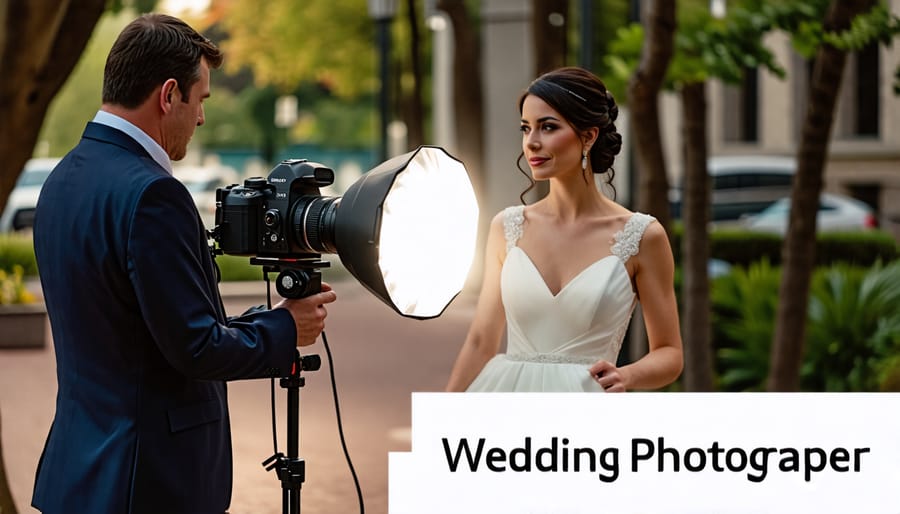
Light Modifiers
When it comes to wedding photography, light modifiers are essential tools for shaping and controlling the quality of light in your images. Two of the most versatile and affordable options for beginners are diffusers and reflectors.
Diffusers help soften harsh sunlight or flash, creating a more flattering and even illumination on your subjects. They come in various sizes and materials, such as translucent fabric or plastic, and can be attached to your flash or held in front of it. Shoot-through umbrellas are a popular type of diffuser that can produce beautiful, soft light for portraits.
Reflectors, on the other hand, bounce existing light back onto your subject, filling in shadows and adding sparkle to the eyes. They are available in different colors like white, silver, and gold, each providing a unique effect. White reflectors offer a neutral fill light, while silver ones create a cooler, more specular highlight. Gold reflectors can warm up the light, which is particularly useful during sunset or golden hour shoots.
When choosing light modifiers, consider their size, portability, and ease of use. As a beginner, opt for versatile options that can adapt to various lighting situations and are quick to set up, ensuring you don’t miss any crucial moments during the fast-paced wedding day.
Accessories and Extras
When it comes to wedding photography, having the right accessories can make all the difference. Spare batteries and memory cards are essential to ensure you never miss a crucial moment due to a dead battery or full card. Invest in high-capacity, reliable options to keep your camera powered up and ready to capture every detail. A sturdy camera bag is another must-have, protecting your gear during transit and keeping everything organized on the big day. Look for a bag with customizable dividers and ample space for your camera body, lenses, and accessories.
A tripod is another valuable tool for wedding photographers, particularly for low-light situations or creative compositions. Choose a tripod that’s lightweight and easy to set up, yet stable enough to support your camera and lens combo. Monopods offer a more mobile alternative, providing stability while allowing you to move around quickly to capture candid moments. Don’t forget about lighting accessories, such as an external flash or reflector, to help you navigate various lighting conditions and add a professional touch to your images. By equipping yourself with these essential accessories, you’ll be well-prepared to tackle the challenges and opportunities of wedding photography with confidence.
Conclusion
Building a wedding photography kit doesn’t have to be overwhelming or expensive. Start by investing in the essential equipment we’ve covered, such as a reliable camera body, versatile lenses, and sturdy tripod. As your skills and business grow, gradually add more specialized items like off-camera flashes, light modifiers, and backup gear.
Remember, the most important factor in creating stunning wedding images is your creativity and technical expertise. Focus on honing your craft, understanding light, and connecting with your clients. With practice and dedication, you’ll be able to capture beautiful, emotional moments that couples will cherish for a lifetime.
As you embark on your wedding photography journey, don’t be afraid to experiment, learn from your mistakes, and seek inspiration from other photographers. Attend workshops, join online communities, and collaborate with fellow creatives to continue growing and refining your skills. With the right equipment and mindset, you’ll be well on your way to becoming a successful wedding photographer.

